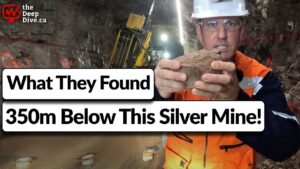WINNEMUCCA, NEVADA–(Marketwired – Aug. 25, 2014) – Paramount Gold and Silver Corp. (NYSE MKT:PZG)(TSX:PZG)(FRANKFURT:P6G)(WKN:A0HGKQ) ("Paramount") announced today the results of a Preliminary Economic Assessment ("PEA") for its 100%-owned San Miguel gold and silver project located in Chihuahua State, Mexico. The PEA was prepared by Metal Mining Consultants Inc. ("MMC") of Denver, Colorado incorporating a resource model developed by Mine Development Associates ("MDA") of Reno, Nevada.
The new PEA confirms that the San Miguel project represents a potentially robust economic opportunity to develop a low-cost mine in the prolific Sierra Madre belt in Mexico. The new PEA adds an efficient, inexpensive open pit, heap leach operation to the front end of the production scenario which helps fund underground mining and related mill construction from cash flow. The new PEA also features a very substantial increase in measured, indicated and inferred resources compared to the 2013 PEA also prepared by MMC. The complete PEA has been filed at SEDAR on August 22, 2014.
Commenting on the results, Paramount CEO Christopher Crupi stated: "This new PEA incorporates a much more mature and efficient design than the one from last year. The additional drilling and metallurgical testing since the first iteration have allowed us to capture a sizeable, near surface, mid-to-lower grade resource in a heap leach operation which generates a substantial economic improvement over last year. Lower average metal prices have reduced the new NPV/IRR calculations from 2013. However, if you run the new design on the same base case metal prices as last year's PEA, which are gold at $1500 and silver at $29, the NPV this year comes in at $792.0 million, a 12% increase from 2013. This apples-to-apples comparison points to the significant progress we have made at San Miguel. We think a prospective partner can now put a reliable valuation on the project."
Project Design and Economics
In their analysis, MMC proposed a 4,000 tonnes per day mill with a heap leaching facility fed by open pits and underground mines, resulting in a projected 17 year operation with a total metal production of 933,000 ounces of gold and 47.1 million ounces of silver (1,700,000 ounces of gold equivalent at the base case gold-to-silver price ratio of 61.4 to 1). Start-up capital costs including owners cost and working capital are estimated at $69.6 million. This is for the development of the heap leach pad and the start of mining operations. Sustaining capital costs over the project's life are projected to be an additional $346.1 million, with 25% sustaining contingency for mill construction included and $21.3 million in EPCM for mill construction in year 2, total life-of-mine capital costs are estimated at $439.5 million. Projected life-of-mine average cash operating costs are $597 per ounce of equivalent gold recovered. The total cost of production (including cash operating costs and total capital and contingency costs over the life of the mine) is estimated at $855 per ounce of gold equivalent, which compares favorably with current producers in the region. Payback for initial capital comes in year 3 of production and payback of mill expansion and underground start-up in year 5.
At a gold price of $1,350 per ounce and a silver price of $22 per ounce, the base case price assumptions, San Miguel has an estimated $841.2 million pre-tax net cash flow, a $472.6 million pre-tax net present value ("NPV") at a 5% discount rate and a highly accretive internal rate of return ("IRR") of 23.2%. Using the prices of the 2013 PEA of $1,500 gold and $29 silver, San Miguel's projected economics improve to $1.3 billion in pre-tax net cash flow, $792.0 million of net present value at a 5% discount rate and a 33.9% IRR.
Mineral Resources
In July 2014, MDA completed a National Instrument 43-101 compliant global resource estimate for the San Miguel project (see news release dated July 8,2014) which was used for the PEA. The San Miguel database used for MDA's resource estimate includes 318 core and 61 reverse circulation drill holes totaling almost 139,000 meters. Total global resource estimates by measured, indicated, and inferred as reported by MDA are as follows: http://media3.marketwire.com/docs/Total-global-resource.pdf.
MMC has determined that the most suitable mining scenario for the project is an underground operation for the high grade Don Ese, a combination of open pit and underground mining for La Union and San Miguel and open pit extraction for San Antonio, La Veronica, Monte Cristo, and San Francisco.
A PEA provides a basis to estimate project operating and capital costs and establish a projection of the potential mineable resource including measured, indicated and inferred categories as permitted under National Instrument 43-101.
The total global mineral resources model prepared by MDA was then used by MMC to estimate open pit and underground mining using the following associated cutoff grades:
| Source and Process | Silver Equivalent Cut-off Grades (gpt) | Associated Gold Equivalent Cut-off Grades (gpt) | |
| Open Pit Mill | 39 | 0.64 | |
| Open Pit Heap Leach | 9 | 0.15 | |
| Don Ese Underground Mill | 150 | 2.44 | |
| San Miguel Underground Mill | 99 | 1.61 | |
| La Union Underground Mill | 104 | 1.69 |
MMC estimated the base case scenario on open pits and underground designs using the following minable material*
| Source | Class | kTonnes | Au gpt | Au kOz. | Ag gpt | Ag kOz. |
| Open Pit Mill | Measured | 512 | 0.59 | 10 | 149.6 | 2,465 |
| Open Pit Heap Leach | Measured | 226 | – | – | 36.8 | 267 |
| Underground Mill | Measured | 2,056 | 2.70 | 179 | 117.4 | 7,757 |
| Open Pit Mill | Indicated | 6,302 | 0.40 | 81 | 103.9 | 21,060 |
| Open Pit Heap Leach | Indicated | 3,334 | 0.15 | 16 | 13.7 | 1,469 |
| Underground Mill | Indicated | 5,119 | 2.84 | 468 | 133.2 | 21,924 |
| Total | Measured & Indicated | 17,550 | 1.34 | 754 | 97.4 | 54,942 |
| Mine | Class | kTonnes | Au gpt | Au Oz. | Ag gpt | Ag Oz. |
| Open Pit Mill | Inferred | 6,341 | 0.44 | 90 | 54.2 | 11,054 |
| Open Pit Heap Leach | Inferred | 8,539 | 0.19 | 52 | 6.8 | 1,860 |
| Underground Mill | Inferred | 1,566 | 2.45 | 123 | 136.0 | 6,849 |
| Total | Inferred | 16,445 | 0.50 | 266 | 37.4 | 19,763 |
| *Note: The PEA evaluated mineral resources which are considered to be too geologically speculative to have the economic considerations applied to them that would enable them to be categorized as mineral reserves and, as such, do not have demonstrated economic viability. There can be no certainty that the estimates contained in the PEA will be realized. |
The potentially minable material in the 2014 PEA has increased significantly from the potentially minable material incorporated into the 2013 PEA. The following table summarizes the increases in mined tonnages:
| Class | 2013 PEA kTonnes | 2014 PEA kTonnes | Increase |
| Measured | 974 | 2,794 | 187% |
| Indicated | 8,807 | 14,756 | 68% |
| Total | 9,782 | 17,550 | 79% |
| Class | 2013 PEA kTonnes | 2014 PEA kTonnes | Increase |
| Inferred | 8,710 | 16,445 | 89% |
Metallurgy
Test work performed at McClelland Laboratories Inc. in Sparks, Nevada, has provided a reliable basis for deriving gold and silver recoveries for each of the deposits included in this PEA. MMC used gold and silver recoveries specific to each of the deposits. Overall, gold recoveries exceeded 90 percent and silver recoveries averaged above 70 percent in cyanide leach bottle roll tests at a grind of 74 microns. Estimates of cyanide and lime consumptions have also been obtained from the test work and were used to develop the processing methodology. The economic scenario defined by MMC incorporated a 4,000 tonne per day mill facility, followed by agitated cyanide leach in tanks with a Merrill Crowe recovery circuit which will produce a dore bar. Additional test work conducted on coarse material in the past year has indicated that Heap Leaching could recover significant metal. MMC has worked to bring the heap leaching case to a planned operating scenario to allow economics to be generated. This result has indicated that the project be started under a Heap Leach operation and delay the mill and underground operations by one year.
Mine Planning
The project will be mined by combined conventional open pit and underground operations. The recommended open pit mining method is conventional drilling and blasting with mineralized material and overburden loaded into rigid frame haul trucks. Mechanized underground mining will be from sublevel open stoping with delayed backfilling. A vertical mining sequence was assumed based on panels defined by local bottom elevations from which vertical overhand mining would proceed. Where required, the panel bottom was assumed to be filled with cemented rockfill, to create intermediate sills to allow underlying panels to be developed later in the production schedule as mining advanced vertically downward. The majority of stope backfilling would use uncemented development waste (unmineralized material) or open pit overburden backhauled from the surface. These mining methodologies are in common use in this region of Mexico.
A summarized production schedule for annual averages for the heap leach startup followed the heap leach and mill production stages of the project is as follows*:
| San Miguel Project Schedule | ||||||
| Project Stage | Heap Leach Start Up | Heap Leach and Mill Production | Life of Mine | |||
| Yearly Averages | Year 1 to Year 2 | Year 3 to Year 17 | Total | |||
| Mineralized Tonnes to Mill | – | 1,394,000 | 20,910,000 | |||
| Au Grade (gpt) | – | 1.40 | 1.40 | |||
| Ag Grade (gpt) | – | 99.05 | 99.05 | |||
| Au Recovery | – | 92% | 92% | |||
| Ag Recovery | – | 72% | 72% | |||
| Recovered Au Oz | – | 60,287 | 877,000 | |||
| Recovered Ag Oz | – | 3,117,771 | 45,416,000 | |||
| Mineralized Tonnes to Pad | 902,000 | 730,000 | 12,754,000 | |||
| Au Grade (gpt) | 0.17 | 0.18 | 0.18 | |||
| Ag Grade (gpt) | 33.55 | 8.75 | 12.26 | |||
| Au Recovery | 77% | 77% | 77% | |||
| Ag Recovery | 33% | 33% | 33% | |||
| Recovered Au Oz | 3,719 | 3,269 | 56,000 | |||
| Recovered Ag Oz | 321,160 | 78,933 | 1,659,000 | |||
| Total Mineralized Tonnes | 902,000 | 2,124,000 | 33,664,000 | |||
| Total Rejected Material Tonnes | 4,249,000 | 4,740,000 | 79,602,000 | |||
| Total Recovered Au Oz | 3,719 | 63,556 | 933,000 | |||
| Total Recovered Ag Oz | 321,160 | 3,196,705 | 47,075,000 | |||
| *Note: Rounding may cause apparent discrepancies |
Key production statistics are as follows:
| Item | Mill | Heap Leach |
| Annual Gold Production (kOz) | 64 | 3.3 |
| Assumed Gold Recovery | 94% | 77% |
| Annual Silver Production (kOz) | 3,169 | 74 |
| Assumed Silver Recovery | 72% | 33% |
| Project Element | Open Pit | Underground |
| Mined Mineralization (kTonnes) | 25,498 | 8,807 |
| Mined Waste (kTonnes) | 76,862 | 2,729 |
| Strip Ratio | 3.01 | 0.31 |
| Contained Au (kOz) | 234 | 764 |
| Contained Ag (kOz) | 35,234 | 36,601 |
| Mined Resource Classification | ||
| Measured (% of mineralized tonnes) | 3% | 23% |
| Indicated (% of mineralized tonnes) | 38% | 58% |
| Inferred (% of mineralized tonnes) | 58% | 18% |
Capital Costs
Capital costs were developed based on scaling costs from similar facilities for production rates and from design basis assumptions. The costs are collected in three separate categories; (1) Initial capital (construction costs to initiate mining and heap leaching operations including EPCM, initial contingency, pre-stripping, working capital and start-up owners cost), (2) Sustaining capital (costs due to delayed construction of the mill, sustaining contingency for the mill, delayed development of the underground mines, plus additions to the mobile mining equipment fleet and equipment rebuilds, and (3) Sustaining EPCM estimates. The estimated capital costs are as follows:
| Capital Category | Costs |
| Initial Capital | $69.6 million |
| Sustaining Capital | $346.1 million |
| Sustaining EPCM | $23.8 million |
| Total CapEx | $439.5 million |
Operating Costs
Operating costs are based on similar mining operations in the immediate area of San Miguel and on information on other mining operations in North America using similar mining methods. Operating cost estimates are as follows:
| Unit Costs | Costs |
| Open Pit Overburden Mining (US $/Tonne) | $1.59 |
| Open Pit Mineralized Mining (US $/Tonne) | $1.94 |
| Underground Mining per tonne Mined and Transported to Crusher (US $/Tonne) | $36.31 |
| Open Pit Mining Cost per tonne processed (US $/Process Tonne) | $5.94 |
| UG Mining Cost per tonne processed (US $/Process Tonne) | $46.19 |
| Processing Cost per tonne milled (US $/Process Tonne) | $13.75 |
| Operating Cost per tonne leached (US $/Process Tonne) | $3.00 |
| Administration Cost per tonne processed (US $/Process Tonne) | $5.00 |
| Reclamation Cost per tonne processed (US $/Process Tonne) | $1.62 |
Economic Analysis
The base case economic evaluation used a close to current metal prices and lower than historical three-year trailing averages for gold and silver prices. This approach is more conservative than the guidance of the United States Securities and Exchange Commission, is accepted by the Ontario Securities Commission and is an industry standard. A second case was prepared using the gold and silver prices used in the 2013 PEA presented as an upside case. Post-tax versions for each case were prepared using the following: a 0.5% Net Smelter Return; a 7.5% royalty on earnings before interest; depreciation and amortization; a 30% tax on net income as provided by the new Mexican tax regulations implemented in March 2014; and the application of available net loss carry forwards. The pre-tax results for the base case and upside case along with the post-tax base case and upside case are as follows:
| Item | Base Case | Upside Case | Base Case Post-Tax | Upside Case Post-Tax |
| Gold Price Per Ounce | $1,350 | $1,500 | $1,350 | $1,500 |
| Silver Price Per Ounce | $22 | $29 | $22 | $29 |
| Net Cash Flow | $841.2 million | $1,310.7 million | $528.6 million | $831.0 million |
| NPV @ 5% Discount Rate | $472.6 million | $792.0 million | $261.5 million | $467.9 million |
| NPV @ 7.5% Discount Rate | $350.9 million | $619.9 million | $174.2 million | $348.2 million |
| NPV @ 10% Discount Rate | $256.5 million | $485.8 million | $106.8 million | $255.5 million |
| Internal rate of Return (@ 5% Discount) | 23.2% | 33.9% | 15.9% | 23.6% |
| Operating Costs Per Ounce of Gold Equivalent Produced (life of mine) | $597 | $550 | $597 | $550 |
| Total Costs Per Ounce of Gold Equivalent Produced (includes all capital and closure costs) | $855 | $789 | $855 | $789 |
Infrastructure
The development of mining and processing infrastructure was defined in a conceptual plan that was based on a central process facility with a tailings storage facility and a heap leaching facility. Individual open pit mines would be developed as satellite production operations with mineralized material transported to the process site by haul truck. A main electrical power line and power center would be developed at the process facility, with individual power lines going to the underground mining operations at Don Ese, San Miguel and La Union. Don Ese's distance from the main mining and processing facilities will require it to have its own facilities and infrastructure whereas San Miguel and La Union will be able to utilize shared facilities and most of their infrastructure. Underground mines would have separate ventilation and dewatering systems because of their location remote from each other. Access/haul roads would be developed to each mining operation. It is assumed that personnel for the mining operation would live in the local communities or the Town of Temoris and that no camp facility would be constructed.
National Instrument 43-101 Disclosure
The PEA for the San Miguel Project was prepared by Metal Mining Consultants Inc. ("MMC") under the direction of Mr. Scott E. Wilson, CPG and by Mine Development Associates ("MDA") under the direction of Michael Gustin, CPG. The PEA incorporates the work of a number of industry-leading consultants, many of which are Qualified Persons (as defined under National Instrument 43-101) and are independent of Paramount. Scott Wilson has reviewed and approved this press release.
About Paramount
Paramount is a U.S.-based exploration and development company with multi-million ounce advanced stage precious metals projects in northern Mexico (San Miguel) and Nevada (Sleeper). Fully-funded exploration and engineering programs are now in progress at these two core projects which are expected to generate substantial additional value for our shareholders.
The San Miguel Project consists of over 142,000 hectares (over 353,000 acres) in the Palmarejo District of northwest Mexico, making Paramount the largest claim holder in this rapidly growing precious metals mining camp. The San Miguel Project is ideally situated near established, low cost production where the infrastructure already exists for early, cost-effective exploitation. A PEA for San Miguel was completed and announced on February 28, 2013.
The Sleeper Gold Project is located off a main highway about 25 miles from the town of Winnemucca. In 2010, Paramount acquired a 100% interest in the project including the original Sleeper high-grade open pit mine operated by Amax Gold from 1986 to 1996 as well as staked and purchased lands now totaling 2,570 claims and covering about 47,500 acres which stretch south down trend to Newmont's Sandman project. This acquisition is consistent with the Company's strategy of district-scale exploration near infrastructure in established mining camps. A PEA was completed for Sleeper and announced on July 30, 2012.
Cautionary Note to U.S. Investors Concerning Estimates of Indicated and Inferred Resources
This news release uses the terms "measured and indicated resources" and "inferred resources." We advise U.S. investors that while these terms are defined in, and permitted by, Canadian regulations, these terms are not defined terms under SEC Industry Guide 7 and not normally permitted to be used in reports and registration statements filed with the SEC. "Inferred resources" have a great amount of uncertainty as to their existence, and great uncertainty as to their economic and legal feasibility. It cannot be assumed that all or any part of an inferred mineral resource will ever be upgraded to a higher category. Under Canadian rules, estimates of inferred mineral resources may not form the basis of a feasibility study or prefeasibility studies, except in rare cases. The SEC normally only permits issuers to report mineralization that does not constitute SEC Industry Guide 7 compliant "reserves," as in-place tonnage and grade without reference to unit measures. U.S. investors are cautioned not to assume that any part or all of mineral deposits in this category will ever be converted into reserves. U.S. investors are cautioned not to assume that any part or all of an inferred resource exists or is economically or legally minable.
Safe Harbor for Forward-Looking Statements:
This release and related documents may include "forward-looking statements" including, but not limited to, statements related to the interpretation of drilling results and potential mineralization, future exploration work at the San Miguel Project and the expected results of this work, estimates of resources including expected volumes and grades and the economic projections included in the project's PEA. Forward-looking statements are statements that are not historical fact and are subject to a variety of risks and uncertainties which could cause actual events to differ materially from those reflected in the forward-looking statements including fluctuations in the price of gold, inability to complete drill programs on time and on budget, and future financing ability. Paramount's future expectations, beliefs, goals, plans or prospects constitute forward-looking statements within the meaning of the United States Private Securities Litigation Reform Act of 1995 and other applicable securities laws. Words such as "believes," "plans," "anticipates," "expects," "estimates" and similar expressions should also be considered to be forward-looking statements. There are a number of important factors that could cause actual results or events to differ materially from those indicated by such forward-looking statements, including, but not limited to: uncertainties involving interpretation of drilling results, environmental matters, lack of ability to obtain required permitting, equipment breakdown or disruptions, and the other factors described in Paramount's Annual Report on Form 10-K for the year ended June 30, 2013 and its most recent quarterly reports filed with the SEC.
Except as required by applicable law, Paramount disclaims any intention or obligation to update any forward-looking statements as a result of developments occurring after the date of this document.
Chris Crupi
CEO
866-481-2233
Paramount Gold and Silver Corp.
Glen Van Treek
VP Exploration & COO
866-481-2233
Paramount Gold and Silver Corp.
Chris Theodossiou
Investor Relations
866-481-2233

















